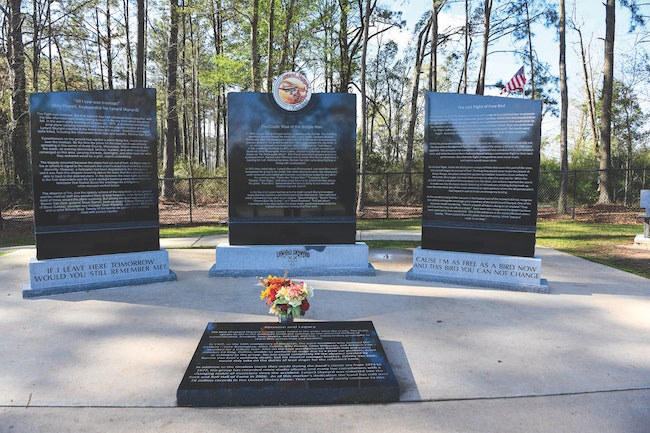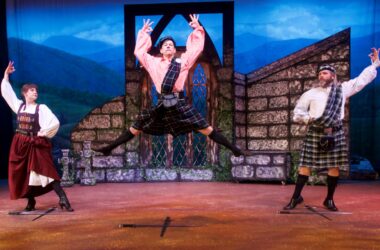 Lynyrd Skynyrd memorial
Lynyrd Skynyrd memorial
 The legendary crossroads.
The legendary crossroads.
 Robert Johnson grave with some gifts.
Robert Johnson grave with some gifts.
March 23 OK, we’re off and running on Day 2 heading up to the Mississippi Delta. Well, we woke up that morning and we didn’t want to wait in a line again like the previous day at Mother’s, so we got there about 7 a.m. And you know, it was an L-shaped kind of counter, you go past all the stuff where you order and then there’s the register at the end and and it was right at the beginning of the yell I remember because the waitress had to tell Bob a couple times, sir, you’re gonna have to move you can’t be blocking the aisle. Down there. So yeah, we had another fabulous breakfast. And, then on the road we went. And the issue with going up into Mississippi is that for the entire state, there’s only six or seven superchargers and unfortunately, we couldn’t start at the beginning of Highway 61 and go up like the jazz musicians did back at the turn of the century. And so we had to take the main north-south highway number again, that goes up to Jackson (the number escapes me). But so we had to go that route because we had to hit a supercharger there. And then we’re going to angle over toward Clarksdale and pick up on Highway 61. And along the way, pass by the great Robert Johnson’s grave marker. So we embarked and we crossed over into Mississippi and shortly after we crossed over into Mississippi, there was a historic marker. It just said historic marker this exit and Bob, on a whim – it must have just meant to be because we’ve actually discussed it a few times – we didn’t think we’d have enough time to go chase it down. We took this marker and then it took us, you know, you take the ‘X’ and then it comes to the ‘T’s into the street. We took a left and we’re going west. And then here’s the sign that says Lynyrd Skynyrd crash site seven or eight miles ahead or something like that. And both Bob and I didn’t go together, but we were both at Lynyrd Skynyrd. It’s the third-to-the-last show in 1977 at the Bayfront Center in St. Petersburg, Fla., and then they played the following night in Lakeland, Fla. And then they went up to Charleston, S.C. Then they were headed down to Louisiana when the plane crashed. And so it was the original band. So we went there and originally we wanted to go to the actual crash site. And this was a memorial that was within a mile or two of the crash site. The actual crash sites are kind of in a boggy area. And so it’d be pretty messy. You’d have to go through people’s property and they just kind of frown on all that, so they set up a memorial that’s as close as they could get to the actual site. They had these three really nice pillars set up and six people died in the accident. Three musicians, the two pilots and one of the crew people and they had to have a Monday on the backside of these three memorials and the memorial things told the story of it all and pretty heavy. You’re just gonna stand there and you can only imagine what that must have been like that many years ago and these people live in around that area. plane coming in low like that. And in the sad day, I remember my mom. I came home I was playing football, I think out the park. That this is a nice park in our neighborhood. And she said, hey, yeah, did you go see a band called like, Leonard Skinner or something the other night in concert? Yeah, why? She has Oh, their plane just crashed. And it was all over. The news. And because there were a Florida band. We’re living in Clearwater at the time. My jaw was slack. Open eyes couldn’t believe it. But so we spent a fair amount of time there you know, about half-hour,45 minutes, and then went on our way and traveled north to, I believe, Jackson, and got ourselves recharged and found out this little trick on the the battery of a Tesla. You can actually when you pull up the gauge, you can put your finger on it and slide it over to the right and get an extra 50 miles of charge. So we started getting 350 charges there at the end and then it was really easy to go from one to one and they recommend you only do that on trips. And then when you come back home and you’re just going to drive around town then put it back to like a 300 mile charge right. So yeah, we got all charged up and then we went and it wasn’t too far down the road where we came across I believe was Mount Zion cemetery. And looking for Robert Johnson’s grave, and they must have had a lot of rain lately. There was standing water here and there and Robert’s grave was pretty easy to spot and had the most flowers and the most booze bottles on the headstand. And there wasn’t much in the way of brass on his grave. So many people trampled. We hung out there for a little while. And the small cemetery, I thought it’d be bigger than that. And so we got back into the car and kept on driving. I mean, you start passing all these, these towns that you know that you hear in all the blues songs and you go through Yazoo City of Yazoo records and things like that and but again, you know, we’re kind of in a race for time. At this point. We were staying on schedule where we had about a half a day of fl uff and we knew that doing the studios was going to eat up more time probably than we were banking on. We went ahead and, and we were kind of racing through time, though, to get to the Blues Museum in Clarksdale, and actually have some time to see stuff in there. We got there with a little over an hour to spare. And which ended up being enough, just barely enough, but enough and you know, and not to downgrade any of it. You know, it’s kind of your typical music museum that you see, regardless of genre. You know, here’s the suit and shoes and hat and, you know, pants and a full suit that so and so wore you know and my show the picture of the album cover of the concert, and that’s always kind of neat stuff always like that. Yeah, you see these dapper clothes that these folks were wearing? You know when you think about it you had a guy like Muddy Waters, who, in 1940 had a guy named Alan Lomax show up at the plantation he was working at living at and had one of these recorders in their trunk. Right, these recorders were the size of a trunk of a car. Yeah. And they would open it up and put out a microphone and you sang into this. Lomax and his son discovered a lot of those old musicians and, yeah, some of the new ones that were coming up like Riley Morganfi eld. And, you know, from there to one decade later, going from the cotton patch to driving around a Cadillac in downtown Chicago. Yeah, for a black person in the 1940s. Life-changing. Big time. Yeah. And the pull just must have been amazing for these people. And so, it’s just neat to see all the just the incredible legacy of this particular area and what it turned out for whatever reason, much like Detroit, and what it had within its area in the early and mid 1960s all these amazing Motown artists. And it’s just often this hotbed San Francisco in the 1960s. Same thing, that whole area, just a, you know, hotbed that just exploded. And you never know where it could happen, right? It can happen in any town, anywhere in the world. So we did the museum. There’s a lot of fun. And we are right now to Clarksdale. Again, it was just one of those rural scenes. The people were nice. Everybody was very polite, but you know, people’s yards and things like that … I know it’s tough … you’re trying to make ends meet … there’s just this needs to be some kind of pride installed in people, you know, you don’t have to have all these dead cars in your yard. Or, you know, the old washer and dryer under the apple tree kind of thing. And I just don’t get that it’s a very common sight on this whole trip, no matter if I was going through Arizona, New Mexico, Texas, or Mississippi, Alabama, Tennessee. It’s kind of like everywhere. Except kind of in your cities. There’s regulations that can have your grass so high. It was eye-opening. So we pulled into Memphis. And I think we’re down to like 20 miles left on our charge. And there’s only one supercharger and it’s all the way out in East Memphis. So we got to the room out there that night. And we still had a little bit of daylight left when we got there. So we pulled into Memphis that evening, and went ahead and turned around and got a good night’s sleep. We’re pretty tired. It was a long day traveling. Bob begins doing the majority of the driving, still 90% plus.








